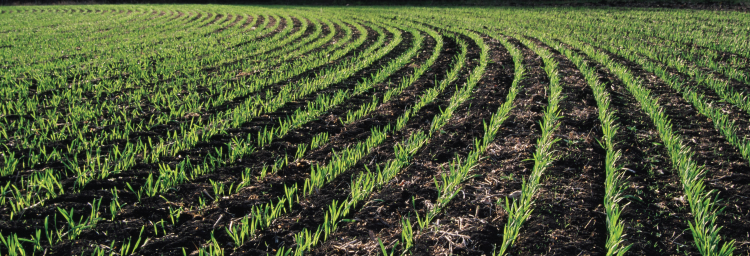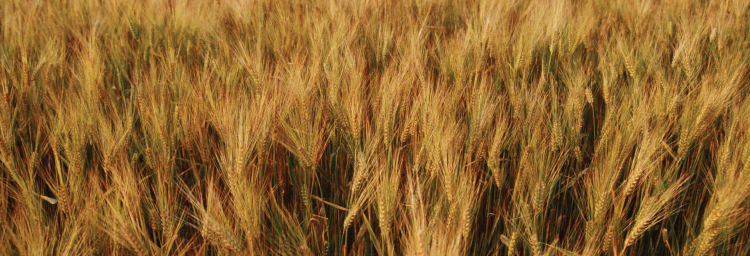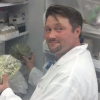Charlottetown Research and Development Centre
The Charlottetown Research and Development Centre (Charlottetown RDC) was established in 1909 in Charlottetown, Prince Edward Island. It is one of Agriculture and Agri-Food Canada's (AAFC) network of 20 research and development centres.
The Centre is associated with two satellite locations:
-
Main laboratory and office complex in Charlottetown; and
-
Harrington Research Farm with field and greenhouse research facilities north of Charlottetown. Watch the Harrington Research Farm virtual tour (video).
Areas of Research
The focus of Charlottetown RDC science activities is on environmental sustainability, diversification and innovation in primary production agriculture, and the discovery and exploitation of bio-based products from new and traditional crops.
The Charlottetown RDC conducts research on diversified, integrated cropping systems with a focus on crop rotations, agronomy of new crops species or cultivars, characterization of crop nutrient cycles and their effects on soil and water quality, as well as the integrated and sustainable management of weeds, insects, and diseases.
Search Research projects from the Charlottetown Research and Development Centre to learn more about what we do.
Sector Needs
The Charlottetown RDC carries out innovative research, development, technology and knowledge transfer activities in support of the AAFC's Strategic Plan for Science, which includes:
Charlottetown RDC develops best management practices in heavily leached areas that are subject to intensive production to ensure sustainable agriculture in sensitive environments. A modern suite of chemistry labs and field research facilities help monitor the effects of cropping systems and practices on soil and ground water health.
Scientists develop integrated cropping systems suited to the Atlantic Region with a focus on the potato crop. Many of the cropping systems studied include cereals, oilseeds, pulses, and forages as part of a rotation involving horticultural crops. Disease, insect, and weed pressure are studied for their impacts on horticulture crops.
Bioproducts research focuses on screening natural products as potential bioprotectants (biopesticides, endophytes); identifying and developing bioenergy, bioindustrial chemicals, and bio-based materials using agricultural biomass platforms (cereals, oilseeds, pulses, forages, potatoes, by-products); and developing conversion technologies and engineering systems through feedstock improvement and utilization.
- Agri-food
New food or feed bioactives with health and wellness benefits are identified through screening, characterized and their preliminary efficacy demonstrated (invitro, cell and tissue culture, animal studies).
Collaboration with cereal and oilseed breeding programs in eastern and western Canada evaluates cultivars and selections for vigour, yield and quality, and identifies/evaluates sources of genetic resistance to production diseases and potentially catastrophic threats.
Clean technologies for the discovery of natural products produced by beneficial soil microbes for the control of pathogens in potato and canola.
Meet our Scientists
Find out more about the scientists at Charlottetown Research and Development Centre through their profiles below.
You can also visit the Fields of Science campaign featuring 11 Agriculture and Agri-Food Canada scientists from coast to coast. Discover why they chose to pursue a career in agriculture and learn more about their research.

More information
Scientists and researchers
Publications
-
Toward evidence that homologs of RPW8 act through salicylic acid signaling in powdery mildew resistance in flax
2023 - View publication details
Vanessa Clemis1,2, Mohsin Zaidi, Frank You3, Chunfang Zheng3, Sylvie Cloutier3, and Bourlaye Fofana1
1Charlottetown Research and Development Centre, Agriculture and Agri-Food Canada, 440 University Avenue, Charlottetown, Prince Edward Island, C1A 4N6, Canada
2University of Prince Edward Island, 550 University Avenue, Charlottetown, Prince Edward Island, C1A 4P3, Canada
3Ottawa Research and Development Centre, Agriculture and Agri-Food Canada, 960 Carling Avenue, Ottawa, Ontario, K1A 0C6, Canada
*bourlaye.fofana@agr.gc.ca
Powdery mildew (PM) is an obligate biotrophic fungus (Podosphaera lini) causing high yield loss to flax (Linum usitatissimum L.). To date, no PM resistance genes have been fully functionally characterized. Using GWAS, we identified a locus harboring three flax homologs of the Arabidopsis RPW8 genes that confer broad-spectrum resistance to powdery mildew. Here, we characterized the gene expression profile of the three RPW8 candidate genes following PM inoculation. The data showed that, similar to RPW8.2 acting through the salicylic acid (SA) signaling pathway, the RPW8 homologs Lus10000835 and Lus10000836 are highly expressed in resistant flax lines compared to the suscpetible lines. In contrast, the flax RPW8 homolog Lus10009328 was highly expressed in the susceptible lines, suggesting a different signaling pathway from the other two homologs. RPW8.1 has been shown to activate ethylene signaling through aminocyclopropane-1-carboxylate oxidase gene isoform 4 (ACO4) and, this elevated ethylene negatively regulates the expression of RPW8.1, thereby attenuating its mediated-cell death and disease resistance when no disease is present to avoid unnecessary defense responses. We conclude that PM resistance induced by RPW8 in flax may mainly be activated through SA signaling pathways, and perhaps similarly to the ethylene signaling in Arabidopsis.
-
Candidate genes for common scab (Streptomyces scabies) and drought resistance in potato as revealed by genome-wide association studies (GWAS)
Bourlaye Fofana, Mohsin Zaidi,, and David MAIN
Charlottetown Research and Development Centre, Agriculture and Agri-Food Canada, 440 University Avenue, Charlottetown, Prince Edward Island, C1A 4N6, Canada*bourlaye.fofana@agr.gc.ca
2023 - View publication details
Potato scab (Streptomyces scabies) is widespread in all potato growing regions, and it significantly reduces potato quality and marketability. Drought, as an abiotic stress, is a major threat to crop productivity. Currently, the genome-wide architecture of the genetic control of these two traits are limited in potato. Here, we used a genome-wide association studies on a 384 diploid potato germplasm panel to determine the potato genomic regions and the genes potentially associated with resistance to scab and drought. Here, we show that three candidate genes located in a 0.5- 5 kb genomic region of chromosome 7 are associated with scab resistance. Furthermore, two major QTNs located on chromosome 5, explained by 16 and 32% of phenotypic variations were found associated with 25 candidate genes. The data will be presented and discussed in a context of global changing climate.
-
Flax Genomic Workshop - Workshop organizer
2023 - View publication details
-
Foster A., Johnstone E., Beaton A., McKenzie-Gopsill A. (2022) AGC ASP-008 - Activities 3 and 4 research update. Atlantic Grains Council Annual General Meeting, Moncton, NB, Nov.24, 2023.
2022 - View publication details
-
McKenzie-Gopsill A, Mills A, Foster A, Wagg C. 2022. Choosing annual cover crops for Atlantic Canada. Atlantic Grains Council Annual General Meeting, Nov 23-24th 2022, Moncton NB Canada.
2022 - View publication details
-
Humphreys G., C. Thomsen, J. Nicoll, L. Langille, O. Wu, M. Hadinezhad, B. Blackwell, A. Cummiskey, A. Foster, D. MacEachern, M. McElroy. (2022) Winter Wheat Improvement for Eastern Canada: 2022 Update. Invited oral presentation (made online) at 2022 Maritime Branch of the CSGA, Moncton, NB, Canada Nov. 22-23, 2022.
2022 - View publication details
-
McKenzie-Gopsill A, Mills A (2022) The importance of species selection in cover crop mixture design. Canadian Weed Science Society/ Canadian Society of Agronomy Joint Annual General Meeting, Nov 14-17th 2022, Halifax NS, Canada
2022 - View publication details
-
MTA AGR-19473 for incoming plant materials
2022 - View publication details
-
Johnstone, Matters and Foster 2022. Survey of Fusarium head blight and leaf diseases of spring wheat on Prince Edward Island, 2021. Canadian plant disease survey 2022 volume 102: disease highlights 2021, Canadian Journal of Plant Pathology, 44:sup1, S1-S187, DOI: 10.1080/07060661.2022.2076342.
2022 - View publication details
-
Cloutier S, Fedak G, Fatima F, Bartaula S, McCallum B, Henriquez MA, Blackwell B, Aboukhaddour R, Foster A, Hiebert C, Humphreys G, McCartney C, Pozniak C, You F (2022) Tapping into wild relatives to improve wheat. ProciNorte Disease Task Force Webinars - Wheat & Grapes: Mitigating the effects brought on by climate change, Sept 13 & 15, Virtual (oral – invited)
2022 - View publication details
- ‹ previous
- 3 of 43
- next ›















